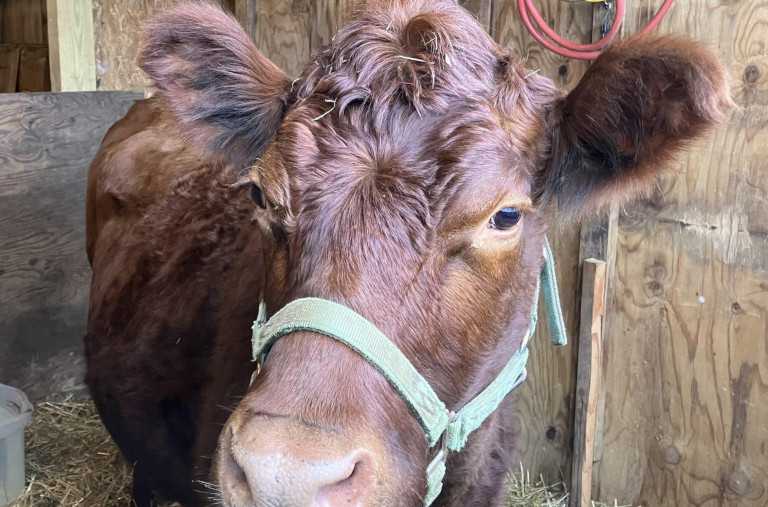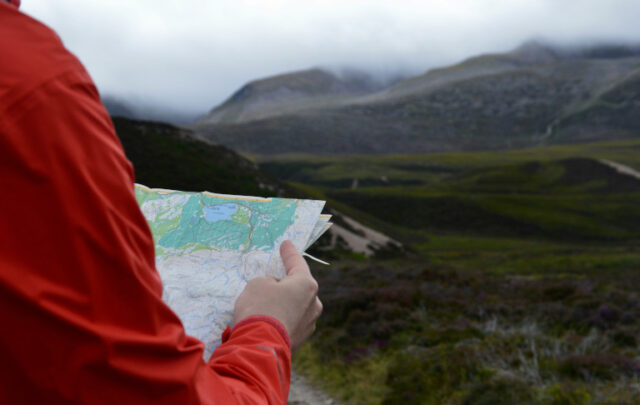One week ago my husband and I bought our first dairy cow.
It was a long-awaited step in our bigger plan to move toward more resilient, regenerative, and participatory food provisioning, among many other things.
But let me tell you, the fact that we anticipated it didn’t make it any less startling.
Life is full of occasions like this. We know they’re coming yet still manage to feel surprised when they actually happen. Milestone birthdays, making a big move, and welcoming a first child come to mind.
Those would be fun essays to write. At the moment, though, a different point is clamoring to be made.
Thirty-six hours (and a few ups, downs, and lurches) into this roller coaster ride, it dawned on me: our personal transition experience is, in many ways, a microcosm of Transition writ large.
Microcosm: a community, place, or situation regarded as encapsulating in miniature the characteristic qualities or features of something much larger.
As a smaller version of that space between the way things were and what comes next, it contains lessons that apply to us all. I share key parts of our story here (from my perspective) to highlight a dozen or so of them.
First, some context.
The Evolving Plan
Tim and I have wanted to farm since we married twenty years ago. I value high-quality delicious food, wanted to participate more fully in caring for the land I inhabit, and have an insatiable appetite for learning. Tim loves working outside, has always dreamed of growing tons of vegetables, and is generally up for just about anything.
Until now our efforts involved gardens, fruit and nut trees, chickens, and, for a time, ducks. That’s all been wonderful, but the more I learned, the stronger my conviction grew that creating systems for sustainably producing abundant, local, nutrient-dense food required entering into partnership with a much greater community of soils, plants, and animals.
More specifically, in order to restore the degraded soils under our feet while getting a yield tomorrow, all without relying on intensive use of fossil fuels, we’d need lactating ruminants. They can eat what we can’t, and in places we can’t easily work. Managed well, these marvelous herbivores can make ongoing good use of the grasses, weeds, and other plants naturally growing around us—turning them into milk, manure, muscle, and more of themselves.
The challenge was that this required land and we didn’t have any, nor the funds to buy it. Wanting to avoid being enslaved by debt, we got creative. We answered a couple ads placed by aging farmers, were in negotiations with a land trust, and considered going in with friends and neighbors. Nothing panned out.
But I was determined.
A now-or-never moment in 2022 prompted me to take bold action. I overcame the resistance I’d had to collaborating with the college where I teach and finally allowed my brain to consider the no-brainer I’d been ignoring: establish an experimental regenerative farm on an unused parcel of land at the school’s field station. After all:
- It’s the ultimate setting for interdisciplinary hands-on learning, which Hiram prides itself on.
- The opportunities it offers align well with many of our existing classes (e.g., Permaculture, Food, Community, Creating Resilience, and more).
- The research and internship possibilities are endless.
- It would be a great venue for hosting community workshops.
- It answers students’ growing demand for learning practical skills and doing “real” stuff.
- It aligns well with the College’s mission to prepare students to “…flourish in life, and face the urgent challenges of the times.”
In short, this project would provide education for what I like to call the real 21st century (playing on a cliché in higher ed), or at least certain neglected aspects of it.
I sketched all this out in an email to the President, squeezed my eyes shut, and hit send.
Within the hour, he replied with an enthusiastic “yes!” and things were in motion.
Lesson 1: Cultivate the desire for something better. Then take actions that will move you in that direction. We need to get scrappy in using the circumstances we have today to develop the vision, infrastructure, and education we’ll need tomorrow.
Many emails, meetings, and administrative turnovers later, we found ourselves laying the groundwork for our hybrid private/educational smallholding.
By fall of 2023, we put in 480 square feet of garden beds, ran a couple of small workshops, deconstructed a barn that was about to be demolished and used the materials to reconstruct a smaller one on site and, with the help of some good friends, installed a strong perimeter fence—critical if we were going to keep animals at this location.
Fast forward to the blessed event.
Ready or Not, Here We Go
After several leads on the cow/calf pair we were seeking dead-ended, we almost resigned ourselves to waiting until next year. A spontaneous late-night Craigslist search changed all that. There was no calf, but the six-year old Jersey-Hereford cow in the ad sounded perfect.
Upon seeing her and meeting Samantha, a helpful and outgoing cow-enthusiast who assisted the owner with posting and communications, we were sold.
A couple weeks later, we were back to pick up our cow.
The handshakes and goodbyes were pleasant enough, as was the 25-minute ride to her new home. I stopped for a few supplies, while Tim went on ahead to direct the hauler.
Then things got interesting.
Turns out we weren’t as prepared as we should have been. The initial disembarking was more than a little traumatic for all parties.
In hindsight, it’s hard to imagine how we could have failed to think of such basic things as backing the trailer up to the gate, setting up a corral to lead her into the barn, having sweet feed on hand to coax her in our desired direction. It’s embarrassing to admit, but true. We did none of that.
After some initial steps walking on a lead rope behind Tim, our cow got spooked and took off running up the gravel road, dragging Tim on a brief but wild ride through the mud until he had the sense to let go.
At this point, things could have gone much worse, but fortune intervened.
There was the miraculous appearance of a stranger up ahead whose outstretched arms caused the fleeing bovine to re-evaluate her direction, the kindhearted hauler who stuck around to help (thank you, Chuck!), and a fortuitously placed chain link fence that stopped her from moving past us in the opposite direction long enough for us to tie her there while we made a plan.
Some swift rearranging of gate, truck, and humans got her on the correct side of the fence. Check.
We should have known and done better.
Lesson 2: Surprises are inevitable, but much can be foreseen. Prepare as well as you can. Used well, the knowledge and time at our disposal can still increase our chances for a good Transition—one that minimizes suffering and maximizes well-being as much as possible.
No Turning Back
It was just the three of us now: Tim, me, and a disoriented 1,000-pound animal who could not be willed to do anything. We needed to have our wits about us.
We stood with her in that scrubby field, planning to eventually guide her into a paddock secured by electrified polytwine. While Tim was off adjusting posts and twine, my job was to try to entice her to eat some hay and above all prevent her from heading toward the southwest gate which, I was none too pleased to learn, was an unfinished weak spot in the fence.
As she explored, I walked and sometimes ran trying to keep her contained to the northern portion of the field. As things settled down, the adrenaline gradually worked its way out of my system. That’s when the dread set in.
The situation seemed impossible. All I could think was: what have we done? My stomach burned.
Even if, in theory, we could sell her back, cancel our plans, and eat our losses, we could not walk away from the needs of this moment. We brought this situation into being and we had to deal with it.
Lesson 3: Wishing things were different will not make them so. We need the fortitude to face and be with what is—even as we work to change it for the better. We can take advantage of countless opportunities to practice this in small ways every day, thereby building our capacity to do so in more challenging times.
I sensed fear wanting to take over. It urged me to run away and never come back, or to just lay down and give up. Fear can be persuasive.
Fortunately, I’m no stranger to this persistent guest. I’ve learned to expect and even welcome it (fear does have its uses). I just don’t give it a seat at the head of the table.
Giving more reasonable inner voices a hearing, I was able to discern next steps.
First order of business: send an SOS to our homesteading friends and mentors. Until now, I only had their email. I described our situation and gave them my number, “in case you think a call is warranted.” (I have a hard time asking for help, even under duress. This was growth!)
Within an hour, Shawn phoned. His reassuring voice and helpful suggestions were lifesavers. Bolstered by his calm and his confidence in us, we proceeded with the plan.
After a little more hide and seek, the cow moved into an open area and Tim courageously took up her lead rope (this time successfully), and led her to a sturdy tree. There he tied her while he went about enlarging the paddock.
Again, I was by myself on watch duty. Fear was back with its relentless refrain of “what have we done?” More acid coursing through my body.
I calmly noticed it without getting swept up in its current. It dissipated.
Lesson 4: Expect fear, but don’t let it dominate. During times of transition, it’s likely to show up when periods of intense action give way to quieter moments, when a new reality begins to set in. Without the presence of mind to see them for what they are, fearful feelings will run the show. That’s almost never a good thing. Cultivating keen awareness of our minds and the feelings that naturally arise and dissolve, on the other hand, dampens our reactivity, allowing for more measured and appropriate responses.
Ups and Downs
Night fell, and so did a little rain. But not much. I was grateful. The weather could have been so much more inhospitable here in Ohio at this time of year. I even managed to take some delight in this impressive animal and the lone star peeking through the murky winter sky.
More waiting. I watched her with interest and confirmed the name we’d considered: Noelle.
Lesson 5: Good and beauty and delight can be found, even in troubled times. We should practice noticing. Giving more airtime to the positive than our negatively biased brains are wont to do on their own does wonders for our outlook.
A couple texts to close friends. Prayers to St. Brigid, patron saint of dairy farmers. Then an errand.
Tim asked me to run to the car to get some of the alfalfa pellets we bought. (We naively thought they’d appeal to her. She didn’t even know what they were.)
As I approached the gate, my phone rang. It was Shawn’s wife, Beth, calling. She has a gift with cows, words, and the human spirit. Exercising her uncanny ability to say just what I needed to hear, she assuaged my fears, reinforced my resolve, and made me laugh, all while offering the most practical of advice.
I returned with a revised plan Tim and I could both feel good about. We would get Noelle into the barn and keep her there for a few days, or as long as needed to get her comfortable in her new setting.
Agreeing on this was huge, as we’d been bickering and butting heads endlessly in recent months. Out of necessity and some kind of mutual sympathy, we found ourselves cooperating and effectively coordinating efforts. Suddenly, so much more seemed possible.
Lesson 6: You can’t do it alone. The experience and wisdom of generous mentors is indispensable. The strengths and gifts others bring, so different from (and sometimes in tension with) our own, turn out to be invaluable. We should be nurturing relationships—encouraging mentorship, a willingness to learn, skillful communication, and simple neighborliness. The web of social connections we make today is the safety net that will soften our fall tomorrow.
I babysat Noelle in the field while Tim set about redesigning the barn door to better suit our current needs. Soon he was leading her into the barn with me trailing behind. Once inside, I closed the lower half-door behind her. We exhaled and took stock. Literally.
One large animal contained.
What I’m sure would have been a piece of cake for experienced cattle handlers, we novices saw as a major victory. A little more setting up and settling in, then it was time go home.
I didn’t sleep much that night. There were so many unknowns, so much to worry about. And the question on repeat: what have we done?
A New Day
I headed to the barn around 6:30 the next morning and was ecstatic to find her safe and sound and munching away.
This day, and the ones that followed, were punctuated by more highs and lows.
As part of her herd now, we spent much of the first couple days with Noelle—keeping her company, letting her get to know us, and rejoicing in some nuzzles.
Our first milking was a struggle. We felt good about having managed to do it, but also dejected, sure we would never get the hang of it. Lucky for us, she wasn’t producing much at this point, so it was a great time to learn.
We continued to be blown away by the ongoing support of Shawn and Beth, and of Samantha, who texted and called periodically to check in on us and insisted on visiting to help out with whatever we needed. Without their counsel and the morale boosts that came with it, we would have been sunk. Refer to Lessons 5 and 6.
I began to notice how the smell of the barn—familiar and not totally unpleasant, but never part of my daily life—was already seeping into my identity, beginning to change it. Interesting. I was also fascinated by other changes quickly taking hold in me—like my relationship with the earth and the fundamental processes that keep life going. Amazing.
Late at night, on the third day of our new life, in the warm dry comfort of our home, a certain sadness came over me. I was reckoning with the obligation we’d taken on—the non-negotiable routines of care, feeding, watering, rotating, and milking—making my previously normal activities seem impossible.
There was a sense of loss. Part of me wanted to go back to the life that was familiar. That sounds melodramatic, I know, but it’s how I felt.
I didn’t cling to that feeling, though, and it eventually passed. Everything does.
Lesson 7: Get to know impermanence. It’s always true that nothing stays the same, but in times of major transition, this truth is in your face and undeniable. And thank goodness. Although we may not want pleasant things to come to an end, it sure is nice when unpleasant things do! Either way, the more we train now in letting go—of the way things were, of our identities, and of other things we might be liable to grasp onto—the freer we’ll be to embrace what life has to offer in any given moment.
As I drove out to the farm the next morning, steeling my nerves for another close encounter with our massive girl, I sensed my spirits starting to fall again and caught them before they hit the ground.
Among the many good interventions I had in my back pocket (thanks to what I’ve learned from wise teachers over the years), THE most powerful one turned out to be remembering why I’m doing something in the first place.
In this case, the reasons are many.
Most fundamentally, everyone needs to eat—ideally fresh, whole, nutrient dense, clean food. And it’s just good sense to develop systems for doing that more locally with as few energy-intensive inputs as possible. But that’s not all we need. There are lots of problems demanding our attention. It just so happens that food systems connect to pretty much all of them.
If we or any group of people, even on a small scale, can produce food while at the same time:
- replenishing soils
- building social networks
- learning and passing on valuable skills
- gaining confidence in our abilities
- reconnecting with nature
- nurturing our spirits
- getting exercise and fresh air
- increasing the resilience of our communities
- using creativity, problem solving skills, and keeping our minds sharp
- experiencing the possibility of other ways of being
- finding beauty, having fun, and more,
then it’s a worthy endeavor indeed.
Lesson 8: Remember your why. Purpose and meaning are not luxuries, they are human necessities. Having good ones can get us through even the hardest of times. Playing a part in getting humanity, or even just our own communities, off this crash course and onto a path to a better future while at the same time creating greater well-being today is not a bad raison d’être.
More Lessons
There’s so much more to say, but I’ve gone on too long already. I’ll close by quickly summarizing just a few more reminders this experience had to offer.
While Tim and I still have much to learn, we are grateful to have picked up as much as we have over the years. That time to research and think and plan saved us from making a number of costly mistakes. To err is human, but to avoid it when possible is pretty great.
Lesson 9: Learn what you can now, while in a non-emergency situation. When it comes to the practical skills needed to take care of ourselves and others, we have a lot of catching up to do. There’s no time to lose. And there’s so much to gain in setting ourselves and our young people to satisfying and purposeful tasks.
As they say, the more you learn, the more you know how much you don’t know. You also end up hearing about all that can go wrong. Even the most level-headed books about a subject—be it babies or cows—are loaded with scary scenarios that make you want to just forget the whole business.
Lesson 10: Be aware of potential problems, but don’t dwell on all that can go wrong. Most of the worst cases won’t happen, but some might. Either way, stuff will go wrong. That’s part of the deal. Let’s solve for what we can in advance and practice dealing gracefully with whatever’s happening by implementing Lessons 2-9 above.
In addition to opportunities to learn, we’ve come to really appreciate the other amenities currently at our disposal. For example, getting ourselves set up would be so much harder if we didn’t have electricity at the barn, running water nearby, convenient communication technologies, robust supply chains, abundant materials on hand, and so forth.
Lesson 11: Take advantage of the resources currently available. Any number of things could interrupt the easy access we take for granted. Let’s lay the groundwork now, while these advantages are in place.
And finally, a lesson I keep learning again and again. Books and videos and blogs are great. And I could avail myself to them ’til the cow comes home. But I can only really know how to do something by doing it—very imperfectly at first and improving as I go. There’s just no way around it.
It’s the same with any kind of transition.
Lesson 12: The only way to get to the “other side” of a transition is through. Doing things we’re not good at (yet) feels awkward; it’s uncomfortable not to know how things will turn out. But our experience of Transition will be determined by what we’re doing, and not doing, today at multiple levels. So, let’s get doing.
What’s Been Missing
As a sociology and environmental studies professor, I’ve spent decades reading, writing, and teaching about the systemic changes needed to avert the worst of projected outcomes for people and the systems we depend on.
It’s truer than ever. We’re way behind, but I’m deeply grateful to those who have devoted their lives to efforts in that direction.
It’s also true that what we do as individuals, families, organizations, and communities matters profoundly.
Not because our actions will “save the planet” or even put a dent in the damage, but because, among other reasons, it will directly impact the quality of our lives—in the midst of and beyond the transition, as well as in the days leading up to it.
Reflecting on the above lessons conveyed by our little initiation into a new way of life, one thing is clear.
In addition to whatever technical, infrastructural, and informational preparations we should have underway, we need, at the same time, to be developing ourselves in particular and interrelated ways—our bodies, minds, and spirits.
Attention to our overall well-being has been mostly absent in the culture at large and certainly in educational institutions. It’s the part of our collective work I’m especially interested in.
In particular, these lessons from our microcosm highlight the importance of training our minds and cultivating our spirits in preparation for whatever tomorrow (or today, for that matter) might bring.
This work is paramount, and we can start now.
After all, beyond the material stuff we’ll need, moving through the in-between gracefully will require calm, courage, cooperation, hard work, and a whole lot of letting go . . . lest we allow ourselves to be dragged through the mud any longer than necessary.





